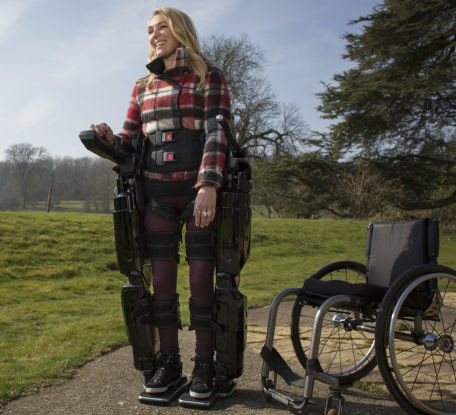Thought-controlled movement

The stentrode. This tiny device is the result of a collaboration of 39 brilliant minds from 16 departments across the University of Melbourne’s medicine, science and engineering faculties.
Smaller than a paperclip, the stentrode, implanted into a blood vessel next to the brain’s motor cortex, will one day allow paraplegics to move with the power of thought.
Once implanted, it picks up signals that would normally be sent to a person’s limbs to create movement.
Instead, the signal will be sent to a computer, which will then transmit it to a robotic exoskeleton attached to the person’s limbs.
The stentrode can record brain signals from within a blood vessel next to the brain. The idea of wirelessly thought-controlled limbs is becoming reality and all the patient will have to do is think about it.
After initial proof-of-concept research demonstrated the capability of the device to pick up neural signals that could be used to control external equipment, the device is now being enhanced by the team at the University of Melbourne, Royal Melbourne Hospital and the Florey Institute of Neuroscience and Mental Health.
In early 2018, a select group of paralysed patients in Australia will be chosen for the trial, where they will be implanted with the stentrode. If the trial is successful, the team anticipates that the technology could become commercially available in as few as six years.
The chief engineer behind the device is the University of Melbourne’s Dr Nick Opie, a senior research fellow and co-head of the Vascular Bionics Laboratory at the Royal Melbourne Hospital.
Dr Opie was recruited from the bionic eye project.
“I’ve always been fascinated by the integration of man and machine and the ways that people and machines could function together. Fortunately, I was born in the time to do this,” Dr Opie said.
Dr Opie and his team produced the winning design using a flexible material called nitinol, also used in bra underwires, modern glasses frames, orthodontics and bone screws.
It is fitted with tiny recording discs, called electrodes, which sit on the wall of the blood vessel, right next to the brain tissue.
Each disc records electrical activity fired by some 10,000 neurons, which is delivered via delicate wires that run out of the brain and into the neck, and emerge into the chest into a wireless transmission system.
The first patients will most likely be young people who have suffered a traumatic spinal cord injury around six months to a year earlier, who are suitable for exoskeleton legs.
They will be chosen for their level of determination, their resolve and their physiology, Dr Opie said.
“Much like learning to drive a manual car, play an instrument or type on a keyboard, after a period of training the brain remembers what to do and the thoughts become second nature. This is what we expect will happen when people use our device to command wheelchairs, exoskeletons and prosthetic limbs,” Dr Opie said.
Read the original article in Pursuit.
In Conversation with Australasian Institute of Digital Health CEO Anja Nikolic
Hospital + Healthcare speaks with Australasian Institute of Digital Health CEO Anja...
Cutting-edge digital health tools putting plastic, silicon and steel to the sword
The Australian Digital Health Agency's Chief Digital Officer sets out some sustainable...
How are AI models approved for use in health care?
Hospital + Healthcare speaks with the Therapeutic Goods Administration to...




![[New Zealand] Transform from Security Awareness to a Security Culture: A Vital Shift for SMB Healthcare — Webinar](https://d1v1e13ebw3o15.cloudfront.net/data/89856/wfmedia_thumb/..jpg)
![[Australia] Transform from Security Awareness to a Security Culture: A Vital Shift for SMB Healthcare — Webinar](https://d1v1e13ebw3o15.cloudfront.net/data/89855/wfmedia_thumb/..jpg)




